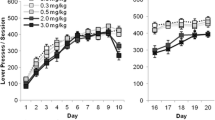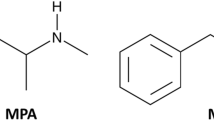Abstract
In an experiment designed to distinguish between the behavioral consequences of treatment with SCH-23390, a D1 dopamine receptor blocker, and raclopride, a D2 antagonist, rats were trained to perform a water-reinforced forelimb operant response. Response rate and the duration of each forelimb contact with the operandum were recorded. In addition, the durations of the rat's visits to the reward well were detected by a photobeam which was blocked by the rat's muzzle as it remained at the reward well. In a between-groups dosing design, separate groups of rats (11–13 rats/group) received SCH-23390 (0, 0.01, 0.02, 0.04, 0.08, 0.12 mg/kg, IP, 30 min) or raclopride (0. 0.05, 0.1, 0.2, 0.4, 0.8 mg/kg, IP, 30 min) for 21 consecutive days. Quantitative analyses indicated that for comparable amounts of operant rate reduction, raclopride had a significantly greater tendency than SCH-23390 to increase the duration of operant responses and to increase the maximum muzzle entry duration (i.e., to induce microcatalepsy). The results support the idea that at relatively low doses D2 antagonism is more likely than D1 antagonism to produce effects identified preclinically with extrapyramidal side effects.
Similar content being viewed by others
References
Ahlenius S (1991) Pharmacological evaluation of new antipsychotic drugs. In: Willner P (ed) Behavioural models in psychopharmacology: theoretical, industrial, and clinical perspectives. Cambridge University Press, Cambridge, Mass, pp 311–330
Barnett A, Iorio LC, McQuade R, Chipkin RE (1988) Pharmacological and behavioral effects of D1 dopamine antagonists. In: Goldstein M, Fuxe K, Tabachnick I (eds) Central D1 dopamine receptors, advances in experimental medicine and biology, vol 235. Plenum Press, N.Y., pp 137–144
Casey DE (1992) Dopamine D1 (SCH 23390) and D2 (haloperidol) antagonists in drug-naive monkeys. Psychopharmacology 107:18–22
Coffin VL, Latranyi MB, Chipkin RE (1989) Acute extrapyramidal syndrome in cebus monkeys: development mediated by dopamine D2 but not D1 receptors. J Pharmacol Exp Ther 249:769–774
Damsma G, Robertson GS, Tham C-S, Fibiger HC (1991) Dopaminergic regulation of striatal acetylcholine release: importance of D1 andn-methyl-d-aspartate receptors. J Pharmacol Exp Ther 259:1064–1072
Faustman WO, Fowler SC (1982) An examination of methodological refinements, clozapine, and fluphenazine in the anhedonia paradigm. Pharmacol Biochem Behav 17:987–993
Fowler SC (1987) Force and duration of operant response as dependent variables in behavioral pharmacology. In: Thompson T, Dews PB, Barrett JE (eds) Neurobehavioral pharmacology, advances in behavioral pharmacology, vol 6. Erlbaum, Hillsdale, N.J., pp 83–127
Fowler SC, Kirkpatrick MA (1989) Behavior-decrementing effects of low doses of haloperidol result from disruptions in response force and duration. Behav Pharmacol 1:123–132
Fowler SC, Liou J-R (1992) Sensitization and tolerance to haloperidol's effects on operant behavior. Soc Neurosci Abstr 18:1534
Fowler SC, LaCerra MM, Ettenberg A (1986) Effects of haloperidol on the biophysical characteristics of operant responding: implications for motor and reinforcement processes. Pharmacol Biochem Behav 25:791–796
Fowler SC, Liao R-M, Skjoldager PD (1990) A new rodent model for neuroleptic-induced pseudoparkinsonism: low doses of haloperidol increase forelimb tremor in the rat. Behav Neurosci 104:449–456
Fowler SC, Skjoldager PD, Liao R-M, Chase JM, Johnson JS (1991) Distinguishing between haloperidol's and decamethonium's disruptive effects on operant behavior in rats: use of measurements that complement response rate. J Exp Anal Behav 56:239–260
Gerfen CR (1992) The neostriatal mosaic: multiple levels of compartmental organization in the basal ganglia. Annu Rev Neurosci 15:285–320
Goldstein M, Lew JY, Meller E (1988) Biochemical and functional characterization of central dopamine receptors. In: Goldstein M, Fuxe K, Tabachnick I (eds) Central D1 dopamine receptors, advances in experimental medicine and biology, vol 235. Plenum, N.Y., pp 43–53
Hillegaart V, Ahlenius S (1987) Effects of raclopride on exploratory locomotor activity, treadmill locomotion, conditioned avoidance behaviour and catalepsy in rats: behavioural profile comparisons between raclopride, haloperidol, and preclamol. Pharmacol Toxicol 60:350–354
Iorio LC, Barnett A, Leitz FH, Houser VP, Korduba CA (1983) SCH23390, a potential benzazepine antipsychotic with unique interactions on dopamine systems. J Pharmacol Exp Ther 226:462–468
Iorio LC, Cohen M, Coffin VL (1991) Anticholinergic drugs potentiate dopamine D1 but not D2 antagonists on a conditioned avoidance task in rats. J Pharmacol Exp Ther 258:118–123
Kirkpatrick MA, Fowler SC (1989) Force-proportional reinforcement: pimozide does not reduce rats' emission of higher forces for sweeter rewards. Pharmacol Biochem Behav 32:499–504
Ljungberg T, Enquist M (1990) Effects of dopamine D1 and D2 antagonists on decision making by rats: no reversal of neuroleptic-induced attenuation by scopolamine. J Neuroal Trans [Gen Sect] 82:167–179
Lynch MR, Carey RJ (1990) Chronic low-dose haloperidol effects on self-stimulation rate-intensity functions. Psychopharmacology 102:122–129
Morelli M, Di Chiara G (1985) Catalepsy induced by SCH 23390 in rats. Eur J Pharmacol 117:179–185
Nakajima S (1989) Subtypes of dopamine receptors involved in the mechanism of reinforcement. Neurosci Biobehav Rev 13:123–128
Ögren SO, Hall H, Kohler C, Magnusson O, Sjöstrand SE (1986) The selective D2 receptor antagonist raclopride discriminates between dopamine-mediated motor functions. Psychopharmacology 90:287–294
Sanberg PR, Bunsey MD, Giordano M, Norman AB (1988) The catalepsy test: its ups and downs. Behav Neurosci 102:748–59
Senyuz L, Fowler SC (1994) Raclopride, but not SCH 23390, induces maldirected jumping in rats trained to perform a run-climb-run behavioral task. Psychopharmacology 112:518–520
Surmier DJ, Reiner A, Levine MS, Ariaon MA (1993) Are neostriatal dopamine receptors co-localized? Trends Neurosci 16:299–305
Waddington JL, O'Boyle KM (1989) Drugs acting on brain dopamine receptors: a conceptual re-evaluation five years after the first selective D-1 antagonist. Pharmacol Ther 43:1–52
Walker JM, Bowen WD, Walker FO, Matsumoto RR, DeCosta B, Rice KC (1990) Sigma receptors: biology and function. Pharmacol Rev 42:355–402
Wise RA, Spindler J, DeWitt H, Gerber GJ (1978) Neuroleptic-in-duced “anhedonia” in rats: pimozide blocks the reward quality of food. Science 201:262–264
Wise RA (1982) Neuroleptics and operant behavior: the anhedonia hypothesis. Behav Brain Sci 5:39–87
Author information
Authors and Affiliations
Rights and permissions
About this article
Cite this article
Fowler, S.C., Liou, JR. Microcatalepsy and disruption of forelimb usage during operant behavior: differences between dopamine D1 (SCH-23390) and D2 (raclopride) antagonists. Psychopharmacology 115, 24–30 (1994). https://doi.org/10.1007/BF02244747
Received:
Revised:
Issue Date:
DOI: https://doi.org/10.1007/BF02244747




